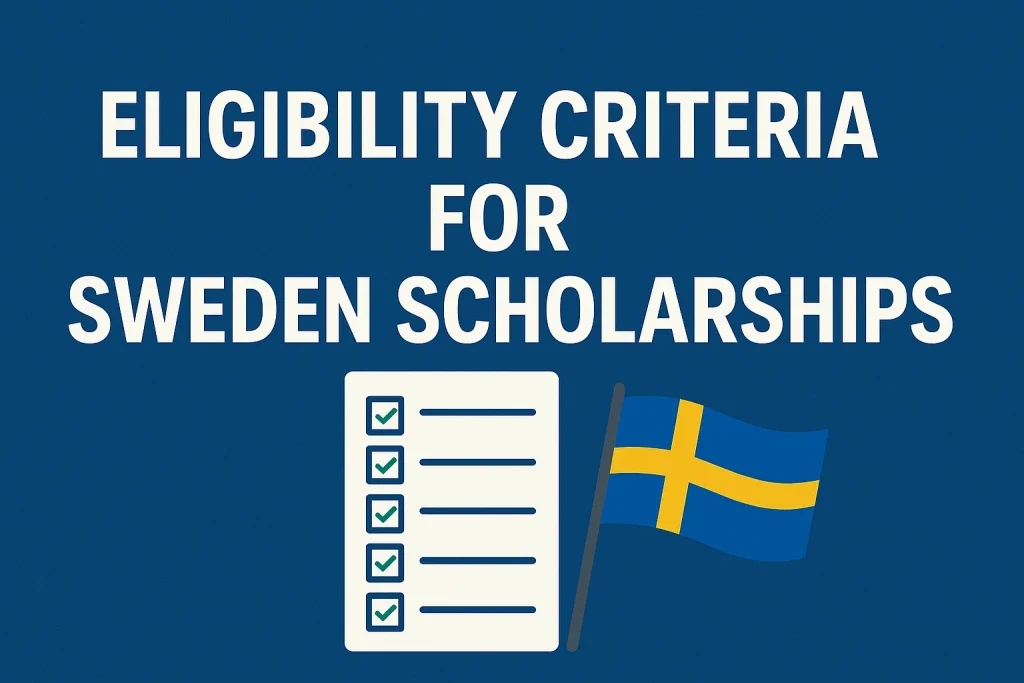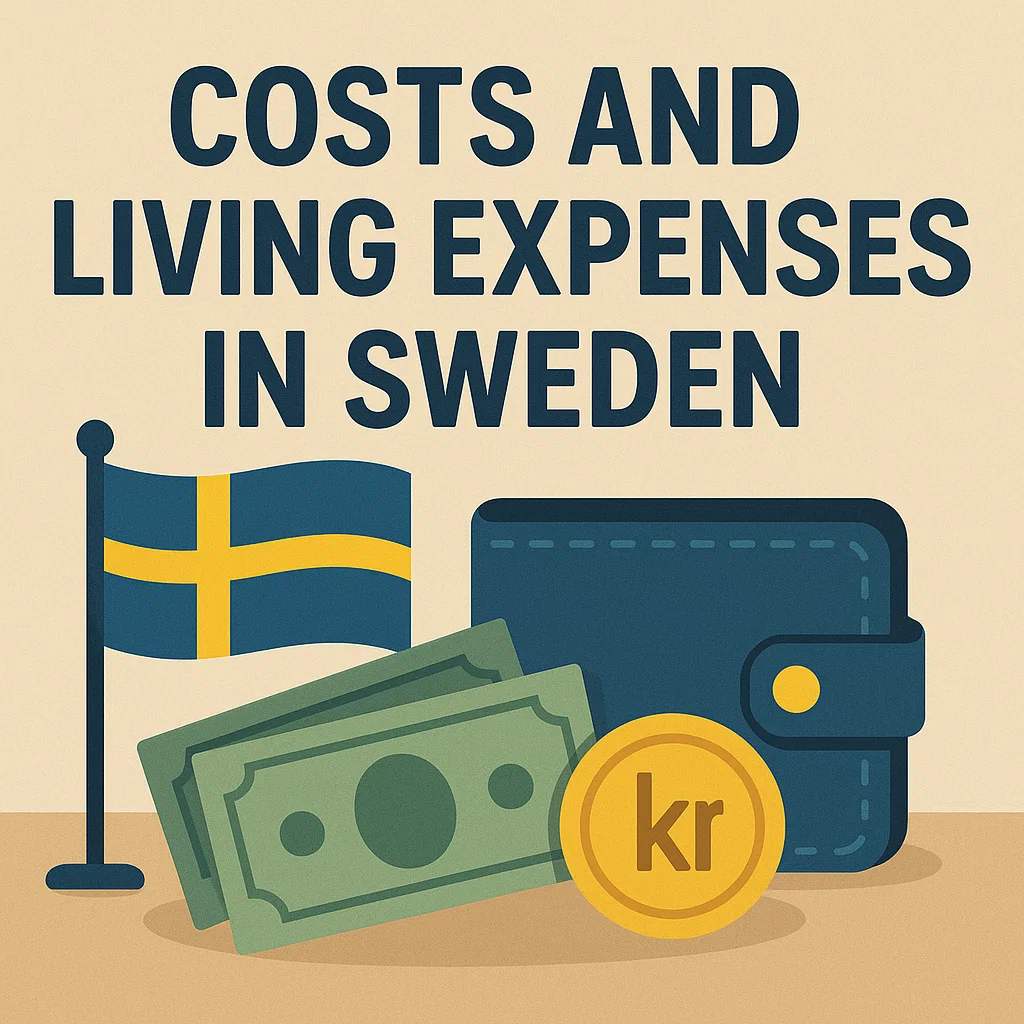Sweden isn’t just known for its scenic landscapes, innovative design, and high quality of life—it’s also home to one of the most progressive education systems in the world. For students dreaming of studying abroad in Europe, Sweden offers an irresistible mix of academic excellence, cultural vibrancy, and—perhaps best of all—generous scholarship opportunities.
We’ve spent years researching and writing about global education systems, and Sweden consistently stands out. From government-backed initiatives to university-specific awards, the country opens its doors to international students from all walks of life. And with the 2025–2026 scholarship season around the corner, there’s never been a better time to explore these fully funded opportunities.
Let’s face it: international education isn’t cheap. Tuition fees, living expenses, visa applications—it all adds up. That’s why scholarships aren’t just helpful; they’re essential. In this guide, we’ll walk you through the best Sweden scholarships for 2025–2026, including who’s eligible, how to apply, what to expect, and how to make the most of your academic journey.
Whether you’re a recent graduate eyeing a master’s program or a professional seeking career advancement, Sweden has something for you. And yes, many of these scholarships are fully funded, meaning they cover tuition, living expenses, and even travel costs in some cases. You’ll also get a front-row seat to a society that values innovation, sustainability, and social equality.
We’ve created this guide not just to inform, but to inspire. Backed by credible sources and years of editorial experience, it’s designed to help you navigate the application process with confidence, clarity, and excitement.
Ready to explore your next academic adventure? Let’s dive in.

Contents
- 1 Top Fully Funded Scholarships in Sweden 2025–2026
- 2 Eligibility Criteria for Sweden Scholarships
- 3 How to Apply for Sweden Scholarships Step by Step
- 4 Tips to Increase Your Chances of Winning a Scholarship
- 5 Costs and Living Expenses in Sweden (With or Without Scholarships)
- 6 Sweden Student Visa Process for Scholarship Recipients
- 7 Comparison of Top Universities Offering Scholarships
- 8 Real Experiences: Testimonials from Scholarship Winners
- 9 Conclusion – Your Roadmap to Studying in Sweden on a Scholarship
- 10 FAQs – Sweden Scholarships 2025–2026
Top Fully Funded Scholarships in Sweden 2025–2026
Finding the right scholarship can be like finding a needle in a haystack. That’s why we’ve compiled a list of the top, fully funded Sweden scholarships for the 2025–2026 academic year. These programs are offered by both the Swedish government and top universities. They cover everything from tuition fees to living costs—and sometimes even travel expenses.
Here’s a quick comparison to help you see what each scholarship offers:
Top Fully Funded Scholarships – Comparison
| Scholarship Name | Coverage | Eligible Levels | Application Deadline | Provider |
| Swedish Institute Scholarships (SISGP) | Tuition, living costs, insurance, travel | Master’s only | Feb 2025 | Swedish Government |
| University of Gothenburg Scholarship | Tuition only | Master’s | Jan 2025 | University of Gothenburg |
| Lund University Global Scholarship | Partial to full tuition | Bachelor’s & Master’s | Feb 2025 | Lund University |
| Uppsala University Global Scholarships | Tuition only | Master’s | Feb 2025 | Uppsala University |
| Karolinska Institutet Global Master’s Scholarships | Tuition only | Master’s | Jan 2025 | Karolinska Institutet |
These scholarships are competitive, but also incredibly rewarding. If your goal is to study in Sweden for free, these are your best options. Each university has its own focus, eligibility rules, and benefits—so choose based on your field and goals.
Eligibility Criteria for Sweden Scholarships

Every scholarship comes with rules. Understanding the eligibility criteria will save you from wasting time—and help you apply with confidence.
Academic Requirements for Bachelor’s and Master’s Programs
To apply for a bachelor’s or master’s program in Sweden, students must meet general and specific entry requirements. For bachelor’s programs, you’ll typically need a high school diploma equivalent to the Swedish gymnasium level. For master’s programs, you must have completed a bachelor’s degree from an internationally recognized university.
You can verify your eligibility using UniversityAdmissions.se, Sweden’s official admissions portal.
Country-Specific Eligibility and Priorities
Scholarships like SISGP give priority to applicants from developing countries or countries that have strategic partnerships with Sweden. If you’re from regions in Africa, Asia, Eastern Europe, or Latin America, you may have a higher chance of selection.
You can check the updated country list for SISGP on the Swedish Institute website.
Language Proficiency Requirements (IELTS/TOEFL)
Most programs are taught in English, and you’ll need to prove your proficiency. The accepted tests include:
- IELTS (academic module): Overall score of 6.5 or higher
- TOEFL iBT: Total score of 90 or higher
Make sure your test results are valid and uploaded to UniversityAdmissions.se before the deadline.
How to Apply for Sweden Scholarships Step by Step
Applying for a scholarship can feel overwhelming. But once you break it down, it’s actually a pretty clear process. Let’s walk through it together.
Preparing Application Documents (CV, SOP, Recommendations)
Start by gathering your key documents:
- A strong CV tailored for academic purposes (Use Europass if unsure)
- A Statement of Purpose (SOP) or Motivation Letter—this is your chance to shine, so make it personal and goal-focused
- Letters of Recommendation from teachers, professors, or professionals who know your academic potential
Each scholarship has its own document format rules. Always double-check the official website before submitting.
Navigating the University Admissions Portal
Sweden uses a centralized application system called UniversityAdmissions.se. Here’s how it works:
- Create an account
- Choose up to four programs you wish to apply for
- Upload your documents (academic records, ID, language proof, etc.)
- Pay the application fee (if required)
Once your application is submitted, you can track its status and get updates directly through the portal.
Application Timelines and Deadlines for 2025–2026
Most applications for Sweden scholarships open around October–December 2024, and close between January–February 2025. It’s important to:
- Start early
- Set reminders for each deadline
- Keep copies of all submissions
Missing a single date can cost you the entire opportunity.
Tips to Increase Your Chances of Winning a Scholarship
Securing a fully funded scholarship in Sweden isn’t just about good grades—it’s about presenting your best self. After years of guiding students through scholarship applications, we’ve seen what works and what doesn’t. Here are practical tips to help you stand out from the crowd.
Writing a Stand-Out Motivation Letter
Your motivation letter (or SOP) is your personal story. It should show your goals, values, and how studying in Sweden fits into your journey.
Tips for a great letter:
- Open with a powerful personal story or insight
- Explain why you chose Sweden and that specific university
- Show how your goals align with Swedish values like innovation and sustainability
- Mention any leadership, volunteer, or professional experiences
If you need help, SI Scholarships offer examples of what they look for in a strong SOP.
Choosing the Right Program and University
Not all programs are equal when it comes to scholarships. Some universities have more funding or specific scholarship quotas for certain fields.
Use the Study in Sweden portal to research programs. Look for:
- Programs that match your background
- Fields in demand, like sustainability, health sciences, or technology
- Universities with a strong record of supporting international students
This increases your chances of admission—and scholarship approval.
Avoiding Common Mistakes During the Application Process
Here are the top mistakes we see, and how to avoid them:
- Missing deadlines: Set reminders or use an app like Notion to stay organized
- Submitting incomplete documents: Always double-check the scholarship checklist
- Generic motivation letters: Customize each letter for each scholarship
- Ignoring small scholarships: Even partial ones can reduce financial stress
Being careful at each step shows the selection committee that you’re serious and detail-oriented.
Costs and Living Expenses in Sweden (With or Without Scholarships)

Even with a scholarship, understanding the cost of living is key to planning your academic journey. Sweden is known for high standards—and yes, prices can be high too. But smart budgeting goes a long way.
Monthly Cost Breakdown for Students in Sweden
On average, students spend about 8,000–10,000 SEK per month (approx. $700–900 USD). This includes:
| Expense Type | Average Monthly Cost (SEK) | Notes |
| Rent (shared) | 3,500 – 5,000 | Depends on city |
| Food and groceries | 2,000 – 2,500 | Cooking at home saves money |
| Public transport | 500 – 700 | Student discounts available |
| Internet/Phone | 300 – 500 | Most plans are affordable |
| Leisure & extras | 1,000 – 1,500 | Movies, cafes, activities |
You can find more details on Study in Sweden’s budget page.
Accommodation, Food, and Transportation
Rent is the biggest expense. Some universities offer student housing, which is often cheaper than private rentals. Check with your school’s housing office early.
Sweden is also big on public transport. In cities like Stockholm, students get a discounted travel card, making it easy to get around.
As for food? Eating out can be pricey. Cooking at home with ingredients from stores like ICA, Lidl, or Willys is the smart way to go.
Student Discounts and Work Opportunities
Sweden offers lots of student discounts on transport, gyms, events, and even tech gear. Just show your Mecenat card to save money.
And yes, you can work part-time. International students can work without a permit, as long as they continue studying. It’s a great way to earn extra cash and gain experience.
Sweden Student Visa Process for Scholarship Recipients
Once you receive your scholarship and admission letter, the next big step is your Swedish residence permit (student visa). Sweden has a clear and digital process, which is a big relief for international students.
Visa Requirements and Financial Proof
To apply for a student visa, you’ll need:
- A valid passport
- Proof of admission from a Swedish university
- Scholarship confirmation (if applicable)
- Proof of funds (unless your scholarship covers living costs)
- Health insurance for the full study period
If your scholarship is fully funded, it usually covers the financial proof requirement. You can read full details on Migrationsverket, the Swedish Migration Agency’s site.
Timeline and Application Procedure
It’s best to apply as soon as you get your acceptance letter, since the process can take up to 3 months.
Steps:
- Create an online account on the Migration Agency portal
- Fill out the residence permit application
- Upload documents and pay the application fee
- Wait for decision and book a biometrics appointment
Start early to avoid any travel delays.
What to Expect Upon Arrival
Once you land in Sweden, you’ll visit the local Swedish Tax Agency to register and get your personnummer (personal ID number). This is essential for accessing healthcare, opening a bank account, or getting a SIM card.
Also, expect a warm welcome! Universities often hold orientation weeks to help you settle in, meet other students, and understand the system better.
Comparison of Top Universities Offering Scholarships
When choosing where to study in Sweden, it helps to compare the universities that offer scholarships. Some schools provide more funding, others have better global rankings, and a few are known for specific programs. We’ve compiled a comparison to help make your decision easier.
| University | Global Ranking (QS 2024) | Scholarship Type | Program Strengths | Location |
| Lund University | #85 | Global Scholarship (Partial/Full) | Engineering, Law, Environment | Lund |
| Uppsala University | #105 | Global Scholarships | Medicine, Physics, Social Sciences | Uppsala |
| Karolinska Institutet | #49 (Life Sciences) | Master’s Scholarships | Health, Biomedicine | Stockholm |
| KTH Royal Institute of Technology | #73 | Tuition Fee Waivers | Technology, Design, Engineering | Stockholm |
| University of Gothenburg | #187 | Tuition Scholarships | Arts, Humanities, Marine Studies | Gothenburg |
These universities are also part of Sweden’s public education system, which means that many of them have strong reputations globally and are committed to academic quality and student support.
Real Experiences: Testimonials from Scholarship Winners
Nothing beats hearing from those who’ve already walked the path. We’ve interviewed a few scholarship recipients to share their journey—from application stress to landing in Sweden.
Stories from Current International Students in Sweden
Sarah from Kenya, a recipient of the SISGP scholarship at Lund University, shared,
“I was nervous about the process, but once I focused on my motivation letter and explained my goals clearly, it all came together. The support from the Swedish Institute made the transition smooth.”
Raj from India, studying Public Health at Karolinska Institutet, noted,
“I chose Sweden because of its research reputation. The scholarship covered everything—from tuition to insurance. Plus, the classroom style here is so collaborative!”
Lessons Learned and Advice from Alumni
Former students often say the motivation letter was their strongest asset. One alum, Emily from Brazil, stressed the importance of tailoring each application:
“Avoid copying and pasting your SOP. Take the time to understand what each program values. I made that effort, and it paid off.”
Others emphasize adjusting to the Swedish academic style, which focuses on independence, open discussion, and real-world applications. You can read more about the study culture on Study in Sweden.
These stories show it’s not just about grades. Passion, clarity, and the right mindset go a long way.
Conclusion – Your Roadmap to Studying in Sweden on a Scholarship
Sweden offers more than just top-ranked universities. It opens doors to a learning experience built on equality, innovation, and global cooperation. And with the right scholarship, that opportunity can be completely within reach.
So, let’s recap your roadmap:
- Start early: Research scholarships and prepare your documents well in advance
- Stay focused: Pick programs that match your goals and values
- Get personal: Craft compelling motivation letters tailored to each scholarship
- Watch the dates: Never miss a deadline or forget a requirement
- Plan for life in Sweden: Budget smartly and understand visa requirements
Every year, thousands of students make the leap—and thrive. We’ve seen firsthand how scholarships change lives. With careful planning and a bit of courage, you could be next.
For more support, visit UniversityAdmissions.se, the official site to apply to Swedish universities, or explore updates from Study in Sweden.
Now it’s your turn. Start your scholarship journey today. And remember—we believe in your dream just as much as you do.
FAQs – Sweden Scholarships 2025–2026
Are Sweden scholarships fully funded for international students?
Yes, several scholarships in Sweden are fully funded. The most well-known is the Swedish Institute Scholarships for Global Professionals (SISGP), which covers tuition, living expenses, travel, and insurance. Some universities also offer full or partial tuition waivers. Be sure to check each program’s specific funding details.
What GPA is required for Sweden scholarships?
There is no single GPA requirement across all scholarships. However, competitive applicants typically have strong academic records—usually equivalent to a B+ average or higher. Check the University Admissions requirements for each program to confirm what’s expected.
Can I work part-time while studying in Sweden?
Yes, international students in Sweden are allowed to work without any time restrictions during their studies. While there is no official hour limit, it’s important to balance work and academics. Learn more about working rights on Study in Sweden.
When is the application deadline for Sweden scholarships 2025–2026?
Most applications for autumn 2025 intake will open between October and December 2024. Deadlines usually fall in January or February 2025. You can find exact dates on UniversityAdmissions.se and the official sites of each scholarship provider.
Do I need IELTS for Sweden scholarships?
Yes, most scholarships and degree programs require proof of English language proficiency. The most accepted tests are IELTS (6.5+ overall score) and TOEFL iBT (90+). Exceptions may apply if you studied in an English-medium institution. Always check the language rules on University Admissions.
What documents are required to apply?
The key documents usually include:
- A valid passport
- Academic transcripts
- Degree certificates
- English proficiency test results
- Motivation letter or SOP
- CV or résumé
- Letters of recommendation
Some scholarships may ask for extra essays or financial documents. Always follow the exact checklist on the official scholarship page.
Are there scholarships for PhD programs in Sweden?
Yes, but they work a bit differently. PhD positions in Sweden are often treated as paid jobs rather than traditional scholarships. When accepted, you receive a monthly salary and work as a researcher. Open PhD positions are listed on university websites and on Euraxess Sweden.